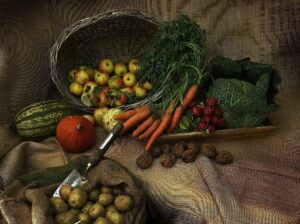
By Sean Sherman
Excerpt from Time Magazine
Every November, I get asked an unfortunate, loaded question: “You’re a Native American—what do you eat on Thanksgiving?” My answer spans my lifetime.
I was born and raised on the Pine Ridge Indian Reservation in South Dakota in the 1970s and am a member of the Oglala Lakota Sioux Tribe. Growing up, I went to a very small country school on the reservation, in the poorest county in the United States. Our school had predominantly Native students, but we were still taught what everybody was about Thanksgiving: It represented a time when “pilgrims and Indians” celebrated together, and it was about being thankful. Only later would we find out that it was a lie.
But as I was taught this story, my family gathered on Thanksgiving at my grandparent’s ranch, where we held a huge feast of very typical recipes, most of them straight out of a circa-‘60s Betty Crocker cookbook. I remember the mingling smells of dishes cooking throughout the day as our moms and aunts crowded every kitchen surface preparing for the large offering. We had the staples, like roasted turkey; mashed potatoes and milk gravy; sweet potatoes with marshmallows; green bean casserole with onion crisps; brand-name stuffing; canned cranberry sauce; an assortment of cold pasta salads, Jello molds, cookies, deviled eggs; and 1950s-style glass platters filled with canned California black olives, pickles and piles of veggies. On occasion, we had Lakota dishes like Taniga (intestine soup) and wojape (chokecherry sauce).
Those are good memories. Though once my grandparents passed away, my family never celebrated holidays like that again, gathered in one place on the reservation. In the years since, my perspective on Thanksgiving has changed—at first from a sense of bitterness surrounding the real history of those lies we tell, of the actual stories we should honor and mourn, and then with a renewed hope for what our celebrations could be, if we simply changed our focus.
People may not realize it, but what every person in this country shares, and the very history of this nation, has been in front of us the whole time. Most of our Thanksgiving recipes are made with indigenous foods: turkey, corn, beans, pumpkins, maple, wild rice and the like. We should embrace this.
For years, especially as the head of a company that focuses on indigenous foods, I have explored Native foods. It has given me—and can give all of us—a deeper understanding of the land we stand on. It’s exciting to reconnect with the nature around us. We Americans spend hours outdoors collecting foods like chanterelles, morels, ramps, wild ginger, chokecherries, wild plums, crab apples, cactus fruit, paw paws, manzanita berries, cattails, maple, wild rice (not the black stuff from California, which is a modified and completely different version of the true wild rice growing around the Great Lakes region), cedar, rose-hips, hickory, acorns and walnuts.
We can work with Native growers producing heirloom beans, squash and pumpkins, and Native corn varieties, all coming in many shapes, sizes and colors. We can have our feasts include dishes like cedar-braised rabbit, sunchokes with sumac, pine-stewed venison, smoked turkey with chestnuts, true wild rice with foraged mushrooms, native squash with maple, smoked salmon and wild teas.
No matter where you are in North America, you are on indigenous land. And so on this holiday, and any day really, I urge people to explore a deeper connection to what are called “American” foods by understanding true Native-American histories, and begin using what grows naturally around us, and to support Native-American growers. There is no need to make Thanksgiving about a false past. It is so much better when it celebrates the beauty of the present.